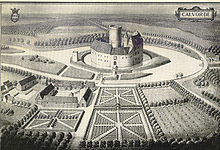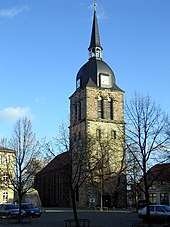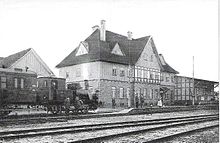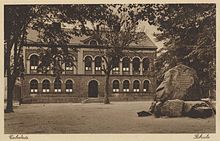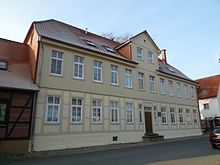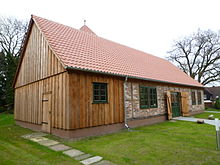Calvörde
| coat of arms | Germany map | |
|---|---|---|

|
Coordinates: 52 ° 24 ' N , 11 ° 18' E |
|
| Basic data | ||
| State : | Saxony-Anhalt | |
| County : | Börde | |
| Association municipality : | Flechtingen | |
| Height : | 52 m above sea level NHN | |
| Area : | 122.07 km 2 | |
| Residents: | 3406 (Dec. 31, 2019) | |
| Population density : | 28 inhabitants per km 2 | |
| Postcodes : | 39359 (Calvörde, Grauingen, Mannhausen, Velsdorf, Wegenstedt) , 39638 (Berenbrock, Dorst, Klüden, Zobbenitz) |
|
| Primaries : | 039051, 039056, 039058, 039059 | |
| License plate : | BK , BÖ, HDL, OC, OK, WMS, WZL | |
| Community key : | 15 0 83 125 | |
| LOCODE : | DE CVO | |
| NUTS : | DEE07 | |
| Community structure: | 11 districts | |
| Association administration address: | Lindenplatz 13/15 39345 Flechtingen |
|
| Website : | ||
| Mayor : | Volkmar Schliephake ( CDU ) | |
| Location of the municipality of Calvörde in the district of Börde | ||
The location of the town of Calvörde in the municipality of Calvörde |
[ kalˈføːɐ̯də ] is a municipality inthe Börde districtinSaxony-Anhalt. In the community there is a branch ofthe Flechtingen community.
geography
Geographical location
Calvörde is about 37 kilometers north-west of the state capital Magdeburg , 21.5 km east-south-east of Oebisfelde and 14 km (as the crow flies ) north-west of Haldensleben between Drömling , Colbitz-Letzlinger Heide and the Flechtinger mountain range . It borders with its municipality on the Altmarkkreis Salzwedel . The Ohre (with the tributaries Wanneweh and Bauerngraben ) and the Spetze flow through the municipality on the Mittelland Canal . From the north, the south-eastern corner towers of the fen territory Drömling to the place Calvörde. The up to 145.7 m high Calvör Mountains run through the municipality from west to south of the core town , a range of ridge that extends from north to south and includes the heights of Rabenberg , Langer Berg , Strahlberg and Mörderberg . The Calvörde forest is located south of Calvörde.
Neighboring communities
| Guards | ||
| Oebisfelde-Weferlingen |

|
Westheide |
| Flechtingen | Bülstringen | Haldensleben |
Community structure
The municipality of Calvörde has the following districts:
|
There are also the following unofficial names for districts:
The following are designated as living spaces:
climate
Annual rainfall is 564 mm. February and October are the months with the lowest rainfall. Most of the rainfall occurs in June, July and August.
history
Early historical finds
In early history, the space between the Elbe and the Ohre was sparsely populated or not at all. The first traces of permanent settlement sites for Calvörde and the surrounding area can be found in the period from 600 to 300 BC. A cemetery with 75 graves was discovered in the Calvör district of Wegenstedt. It is attributed to the early Germanic Jastorf culture. An urn cemetery was found in the Mörderberg forest near Calvörde . The urn group was surrounded by a stone circle (steles). The grave fields were on a hill. The circle of steles and the location on a hill are typical signs of the Jastorf culture. Such graves were always created outside the settlement areas. From this it can be concluded that it was already 300 years BC. There was a permanent settlement in Calvörde without knowing where it was and how long it lasted.
middle Ages
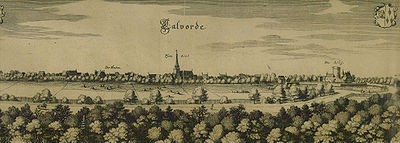
Calvörde was first mentioned in a document in 1196. Where there is a bridge over the Ohre today, there was a ford through the river. There, the Lüneburg Heerstraße, coming from the southeast and leading from Leipzig via Magdeburg to Lüneburg and Hamburg, crossed the river. A second trade route , coming from Braunschweig , was added.
The Leipzig linguist Jürgen Udolph derives the name from the Middle Low German phrase "to der, bi der kalen forde", "near the bare (little overgrown) ford". Local tradition ascribes the origin of the ford to a man named Kale, so the name means Kales-Förde (crossing point of the Kale).
In the 11th century, the Wends tried to secure the transition over the Ohre, but after the assimilation by the Germans in the 12th century, the dynasty families of the Ohre region secured the region around Calvörde. These dynasty families called themselves von Hildesleve, von Amensleve and von Greaves . Otto von Grieben died in 1208, and the castle and the goods went to his son-in-law Ulrich von Regenstein , whose descendants also stayed here for several centuries (including Albrecht and Heinrich von Regenstein). The Calvörde residents had to pay garden and meadow interest, as well as part of the harvest.
Calvörde Castle was first mentioned in the late 13th century . It changed hands several times in the following centuries. In 1571 the castle and town (with the Hünerdorf ) became part of the Principality of Braunschweig-Wolfenbüttel under Duke Julius of Braunschweig . The castle served as a ducal widows estate . In 1737 the dilapidated castle was demolished.
In the year 1306 a Hans von Eilsleve appeared and in 1331 also Bruno, Johann and Gebhard, all named Eilsleve, probably all fiefs of the Lords of Regenstein. From 1318 to 1344 Otto the Mild of Braunschweig and from 1323 to 1334 his wife Agnes owned the castle and the place. Otto's successor was Magnus von Braunschweig . The Braunschweiger gave the castle and the goods to several noble families as pledges for a long time . In 1343 Fritz von Wedderden came into pledge possession, and in 1357 his brother Gerhard for 1400 Stendal silver. In 1369 both donated a free house to the altar of the castle chapel on the new city bridge and made other charitable ecclesiastical foundations in Calvörde.
Already in the 14th century Calvörde had some city rights and was therefore surrounded by moats and huts . There were also two decent city gates , the Gardelegener and the Magdeburg Gate. In 1343 Calvörde also had a council that kept a public city seal . In 1380 Fritz von Wedderden's son, called Gerhard, inherited the lands, including those of his uncle Gerhard von Wedderden. In 1396 Friedrich von Alvensleben came into the possession of the extinct Wedderden, thus also of Calvörde.
Modern times - Reformation - Thirty Years War
In the middle of the 15th century many small villages around Calvörde fell into desolation (Isern, Käsdorf, Ranten, Griebitz and Parwitz), and their inhabitants moved to Calvörde. On July 4, 1492 the place burned down together with the church, but was rebuilt together with the church. On May 11, 1493, Duke Heinrich the Elder visited Calvörde and gave Friedrich von Alvensleben the patronage of the parish church in Calvörde (St. George's Church) and the vicarages there on a temporary basis. In 1518 Friedrich von Alvensleben died and his son Matthias von Alvensleben inherited his property. Because of his mild administration he was very popular. The Calvörder residents enjoyed several grazing and wood rights in the nearby Calvörder mountains. Ten years later Matthias von der Schulenburg , landlord of Altenhausen, came into the lien in Calvörde. He started the Reformation in Calvörde. In 1534 the pledge went to Andreas von Alvensleben, but Ludolf X. von Alvensleben also had a share. But this only lasted until 1559.
In 1561 the main road, which had previously been made of wood, was paved with pebbles. In 1568 the first school was built in Calvörde. In 1571 the castle and the place became part of the Principality of Braunschweig-Wolfenbüttel under Duke Julius von Braunschweig and the Duke united it with his immediate domain (Uthmöden, Zobbenitz, Dorst and Born) around Calvörde. In 1585 Duke Julius von Braunschweig issued a brewing deed to the citizens of Calvörde. Calvörde received a ducal bailiff who had many tasks, including the entire administration, administration of the land, logging, hunting and jurisdiction. In 1677 the official economy in Calvörde was leased separately and the forest and court administration gradually separated from it. The castle remained in the possession of the Dukes of Braunschweig, but the dairy and the outbuilding not far from the castle were converted into apartments for the officials. Duke Julius of Braunschweig often stayed at the castle. His third son, Joachim Carl , Provost of Strasbourg Cathedral , lived in this castle from 1608 to 1615. He donated the altar , pulpit , baptismal font and organ to the Calvörder church .
Around the beginning of the 17th century, the town was given the privilege of holding four annual markets, which boosted trade and commerce there. In the Thirty Years War (1618-1648) the castle was taken by imperial troops; they raged, robbed and pillaged in the official area. Many residents left their homes and farms. In autumn 1627 Calvörde received an imperial letter of protection and some troops were relocated from the castle to the town. On April 29, 1629, the office was handed over by the imperial commissioner, Colonel David Becker, Baron of Honor, to Duchess Anna Sophie von Braunschweig . In 1635 the nearby Zobbenitz was half cremated by Kurland horsemen.
Duchess Anna Sophie died in 1659, and the castle and office of Calvörde went back to the Duke in Braunschweig. The castle has now been occupied by the military. From 1783 to 1796 parts of the Drömling were reclaimed , with the newly reclaimed areas being used as pastureland.
Napoleonic period and restoration
During the Napoleonic period Calvörde was the capital of the canton Calvörde in the Kingdom of Westphalia (1807-1813); the villages of Wieglitz, Bülstringen, Flechtingen, Hasselburg, Lemsell, Hilgesdorf, Grauingen, Mannhausen, Wegenstedt and Etingen belonged to the canton. With the Congress of Vienna , Calvörde became part of the newly founded Duchy of Braunschweig . In 1809 the town of Hünerdorf was incorporated into Calvörde. In 1814 Calvörde was connected to the district office of Vorsfelde . In 1827 a separate district office in Calvörde was established.
Many crafts were represented in Calvörde. There were shoemakers, carpenters, joiners, tailors, blacksmiths, locksmiths, wheelwright and turners. Around 1831 there were 24 brewers and eleven masters of spirits in Calvörde. The place had developed so much that a railway connection was necessary. In 1891 the project of a railway line Neuhaldensleben-Gardelegen-Salzwedel was presented, to which Calvörde should be connected. This plan was not implemented.
For the history of the Jews in Calvörde see: Calvörde Jewish Community
Second German Empire and First World War
With the conclusion of peace after the Franco-Prussian War on January 18, 1871, trees were planted in many places; In Calvörde, three trees were planted in a triangle on the room square, they are to tell future generations about the accomplished times. In 1873 a cholera epidemic broke out, killing many residents. In 1890 a share starch factory, which was the only one in the Braunschweig region, was built. On July 25, 1900, the 50th anniversary of the Calvörde rifle club was celebrated. A bathing establishment was opened on June 23, 1902. For years (from 1894) efforts were made to get a rail connection to the Magdeburg-Oebisfelde state railway. The community felt compelled to build its own small railway towards Wegenstedt. The commissioning took place on October 1, 1909. In 1910 a council meeting decided that four large annual and livestock markets would take place and that a weekly market could be held every Monday. Probably the greatest event during the time of the German Empire was the centenary in Calvörde on March 9, 1913. The 22-ton memorial stone was ceremoniously erected on the market square. It is intended to commemorate the National Liberation of 1813 . With the outbreak of World War I , life changed only slightly. The war was far away, but the shortage of men was noticeable, women had to do the work in the fields, and famine spread in Calvörde towards the end of the war.
Weimar Republic, National Socialism and World War II
After the November Revolution in 1918, Calvörde became part of the Free State of Braunschweig . Life in Calvörde hardly changed, in the 20 years there was a cattle and pig market every Monday. But market life in Calvörde ended with National Socialism. Calvörde had a diverse and rich club life in the 1920s and 1930s. So the shooting festival was always celebrated in the forest village of Grieps. In 1935 the place got a water pipe with very good water quality, before each house had its own well in the yard. In 1922 a war memorial was erected in the cemetery according to the plans of Professor Lüpke from Braunschweig. In 1927 the cemetery chapel was built. On February 17, 1924, the local writer August Oppermann published the Calvörde Heimatlied Calvörde, on the lovely Ohrestrand . Construction of the section of the Mittelland Canal near Calvörde began in March 1934, and a transshipment port was built as early as 1935. Now women again took over the men's work in the fields and in the various factories such as the starch factory and the Herms canning factory. In the spring of 1945 the Allies (British and US Americans) came from the direction of Wegenstedt and Flechtingen; the attempt to blow up the Haldensleberbrücke to stop the Allies was thwarted by Calvörder. Calvörde was taken and the market place became the Allied assembly camp.
Post-war period, GDR and reunification
According to the resolutions of the 1st EAC Zone Protocol from 1944 and the Potsdam Agreement , the Braunschweig exclave Calvörde belonged to the province of Saxony in the Soviet occupation zone . The Red Army entered Calvörde and took cattle, food and building materials from the people. She built small bunkers in the Calvörde forest that are still standing today. A large gate was built on the former southern border to Wieglitz, and a red star was attached to the highest point. With the land reform in 1946, life in Calvörde changed suddenly and refugees had to be taken in. Calvörde was assigned to the district of Gardelegen and later to the district of Haldensleben . Life normalized, in 1952 two branches of the VEAB (Volkseigener Aufkaufbetrieb) were founded. In 1951 a Catholic church was built for the rapidly increasing number of Catholics, as well as the Calvörde consumer cooperative (1954) and a trade organization (1958). An LPG was founded. In 1955 the cinema was completely renovated. In 1967 the small railway line was shut down and a bus connection was set up. The forest village of Grieps became a local recreation area in the Magdeburg district . On January 8, 1990 there was a workers' demonstration in Calvörde. On May 6th, a free and secret local election was held in Calvörde for the first time; the CDU received six seats and the SPD received five seats in the Calvörde municipal council. The Protestant parishes have belonged again to the Braunschweig regional church since reunification . A year after reunification, a memorial stone for German unity was erected on the former station forecourt. Since April 16, 2002, the municipality of Calvörde has officially added the name Flecken .
Historic field names and desolation
There are a large number of historical field names in the district of Calvörde, such as: Teufelsküche, Bullenkuhle, Kälberwiese, Die Koly, Groß- and Klein Ranten, Große- and Kleine Stemmwiese, Hünerdorfer Kabeln, Büchenberg, Ruboldswinkel, Hinter dem Parwitz, Kleines Milchfeld, Holzgärten, Galgenbreite, Fillemaschbreite, Vogelsang, In den Glockenkuhlen, Hopfendämme, Die Dammjuch and Schadwiesen, On and in front of the village, Auf der Rühme, Sponstädtwiesen, Am Holzgraben, Am Drastin, In der Räke, Märtenbreite, Am Hauptwachenber, Siechenbreite, Ox width, Fehn.
Forest corridors: Isernhagen, Calvörder Berge, Griebs, Schierholz, Rantenhorst, Rohrberg.
Desolate villages in the Calvörde Feldmark, to which some field names can be traced back: Isernhagen, Parwitz, Kästorf, Griebitz, Ranten.
Incorporations
On 1 January 2010 the municipality Calvörde from the former municipalities Berenbrock (with Lössewitz and Else Beck), Dorst, Grauingen, Klüden, Mannhausen, Velsdorf, Wegenstedt, Zobbenitz and was stains Calvörde newly established.
Name development
| year | 1196 | 1270 | 1343 | 1345 | today |
| changed name | Kollenvorde | Kalenvorde | Calvoerde | Kalevort, Kalvorde, Calevort | Calvörde |
Population development
|
|
Sources: Chronicle of the city, State Statistical Office
politics
Municipal council
According to the local elections on May 25, 2014, the council has 16 members. The choice brought the following result:
| Calvörde town council | |||
|---|---|---|---|
| list | Seats | ||
| Free community of voters | 5 | ||
| CDU | 4th | ||
| SPD | 4th | ||
| The left | 2 | ||
| FDP | 1 | ||
| As of May 25, 2014 | |||
Another member of the council and its chairman is the mayor.
mayor

- Olaf Schmidt 2010
- Volkmar Schliephake 2010-
coat of arms
The coat of arms was approved by the district on June 10, 2010.
Blazon : "In gold an oblique left blue wavy bar, accompanied by a green willow branch at the top and a green oak branch with acorns at the bottom."
The coat of arms was designed by the municipal heraldist Jörg Mantzsch and included in the approval process. With its symbolism, it ties in with the coat of arms of the former administrative community of Calvörde . Changes consist in the golden tincture of the shield as in the change from the blue bar to the wave bar.
The colors of the parish are green - gold (yellow).
flag
The municipality's flag is striped green - yellow (1: 1) (horizontal shape: stripes running horizontally, longitudinal shape: stripes running vertically) and centered with the municipality's coat of arms.
Coat of arms and flag of the Calvörde district
The coat of arms was approved on December 10, 1993 by the Magdeburg Regional Council.
Blazon : “Split between red and gold; in front a golden lion emerging from the gap, behind three (1: 2) green hop umbels. "
Calvörde was one of the few rural communities that had its own coat of arms. It shows the Brunswick lion and three green hop umbels . This indicates that there used to be hops growing and trading here.
The flag was approved on February 5, 1996 by the Magdeburg Regional Council and designed by Magdeburg local heraldist Jörg Mantzsch .
The flag of the district of Calvörde is yellow and red striped lengthways and centered with the district's coat of arms.
Economy and Infrastructure
traffic

Calvörde is connected to Oebisfelde, Gardelegen, Haldensleben and Erxleben by country roads .
Passenger trains operated by the Wegenstedt – Calvörde Kleinbahn to Calvörde until 1966 (see: Calvörde station ) . Freight traffic on this route was stopped in 1967.
In Calvörde, the L24 from west to east and the L25 from south to north intersect (Altmark feeder). The district roads K 1140 and K 1141 lead from Calvörde to Lössewitz, Zobbenitz, Klüden, Dorst and the K 1651 to Velsdorf and Mannhausen.
The Mittelland Canal , one of the most important waterways in Saxony-Anhalt, runs through Calvörde . For commercial shipping , the is port Calvörde with turning bay near the town center. Southeast, just outside, toward the recreation area Grieps, founded in 2013, a small marina for recreational boating .
Transport links
In the district of Wegenstedt there is a stopping point (see: Wegenstedt station ), which is served by regional trains on the Magdeburg – Wolfsburg line every hour or two hours. The Calvörde station and the Wegenstedt – Calvörde small railway are closed. Bus traffic in Calvörde is provided by two transport companies: PVGS Personenverkehrsgesellschaft Altmarkkreis Salzwedel mbH drives from Klötze via Calvörde to Magdeburg, BördeBus Verkehrsgesellschaft mbH drives to places in the vicinity.
Business settlement after 1990
As early as 1991, Calvörde developed a 45-hectare industrial park on community-owned land, around 90 percent of which is occupied. The globally active Sondermaschinenbau Calvörde GmbH emerged from a state forest machine manufacturer, later Rationalisierungsmittelbau (first GmbH in the new state of Saxony-Anhalt 1990). In addition to the approximately 700 employees in industry, there are around 300 employees in other branches of the economy. Around 350 commuters work in Calvörde.
Established businesses
Around 130 business registrations, from sole proprietorships to medium-sized companies, are represented.
The largest companies are:
- HATEFO Produktionsges. mbH
- Rademacher Transport GmbH, forwarding agents and logistics
- Refresco Germany , beverage production (based in Mönchengladbach )
- SM Calvörde Sondermaschinenbau Calvörde GmbH & Co. KG
education
There are two state schools:
- Secondary school: Brothers Grimm School
- Primary school: "Am Wald" in Wegenstedt
There are also a large number of former schools, these school buildings are now mostly used as residential buildings or as village community centers in the districts. These are in detail the school buildings Schulhaus Mannhausen , Schulhaus Grauingen , Schulhaus Zobbenitz and the Schulhaus Klüden.
Day care centers
In Calvörde there are three day-care centers (crèches and kindergartens) for the age group from 0 to 6 years. There are two available in municipal (“Spetzenpieper” kindergarten in Wegenstedt, “Eichkitten” kindergarten in Zobbenitz) and one in non-profit sponsorship (integrative day care center in Calvörde).
There are also three after-school care centers in the community , in Calvörde, Wegenstedt and Zobbenitz.
Country house for children
In the facility belonging to youth welfare ( children's home ), there are currently around ten children in the 10 to 17 age group. The country children's house is located in the south of the district of Wegenstedt.
media
As a newspaper the Gardelegener, Magdeburg or Haldensleber appears popular vote and the Gardelegener Altmark newspaper as a local issue . The General-Anzeiger appears twice a week as a weekly newspaper . The Haldensleber and Wolmirstedter Sonntag and the ohre Kurier are also published once a week. The Bürger-BZ-Zeitung appears monthly .
Attractions
Churches
- Evangelical St. George's Church as a baroque church from 1729. The baroque organ and numerous epitaphs and tombstones are worth seeing . It is the main church in the parish of Calvörde.
- Catholic Holy Cross Church from 1951, today belongs to the parish of St. Christophorus, based in Haldensleben
- Village church of Wegenstedt , part of the Evangelical Church in Central Germany (EKM)
- Village church Elsebeck , belongs to the parish of Calvörde and thus to the Brunswick regional church
- St. Anna Church , the oldest half-timbered church in the community, belongs to the Braunschweig regional church
Buildings
- Synagogue in Calvörde , is located on Neustadtstrasse
- Löwen-Apotheke Calvörde , was founded in 1669 and is one of the oldest pharmacies in the district, the listed building is on Geschwister-Scholl-Straße
- St. Georg Hospital Calvörde The first hospital was built in the courtyard, after the fire of 1700, the new hospital was built in the former cemetery in Hünerdorf, today 45 Geschwister-Scholl-Straße.
- Remains of the Calvörde Castle
- Half-timbered buildings on the Calvörde market square
- Calvörde cemetery chapel from 1927
- Temps Mühle , tower dutchman windmill (conical) from 1857
- The Castle Dorst was 1922-1923 by the landowner Paul and Margarete Fischer
- The pigeon tower in Dorst , a building from the middle of the 19th century
- The oldest buildings include the Ackerbürgerhöfe Halbemondstrasse 1 and Halbemondstrasse 6 and the former Calvörde forestry department , this building complex is now a listed building and was once the seat of the forest district within the boundaries of the Calvörde district
- The station building in Calvörde , erected in 1907, is a listed building and is located on Bahnhofstrasse; opposite is a unified monument from 1990
- Karl-Liebknecht-Haus (Calvörde) , a listed and historically significant building for Calvörde and the surrounding area during the time of German division
- Sisters' House (Calvörde) , a historic social station
- House of Encounters (Calvörde) , historical social station and today's cultural gathering point within the community
- District court Calvörde , was the birthplace of the art historian and museum specialist Wilhelm von Bode and is today the museum of the Heimatverein Calvörde e. V.
- Vibranssches Haus, was the residence of the mayor family Vibrans, they provided the mayor of Calvörde for centuries
Monuments
- Large memorial stone on the market square, commemorates the founding of the German Empire in 1871, weighs 22 tons and is a natural monument. It was erected on March 9, 1913 to mark the centenary against Napoleonic rule. He also holds a plaque for German unity in 1990.
- Small memorial stone on Zimmerplatz, commemorates the founding of the German Empire in 1871.
- The Calvörde war memorial was erected in 1922 on the Calvörde cemetery. There are also war memorials in the districts, such as in: Mannhausen , Velsdorf , Klüden , Berenbrock (Calvörde) and Elsebeck
- The tomb of the Vibrans family , a tomb protected from the local and local history, consists of three grave slabs and a stele
- A new war memorial for those who fell in World War II is located in the cemetery in Calvörde
- Unity monument in front of the old station building, commemorates the German reunification in 1990
- Numerous traffic monuments (signposts) such as: signposts at Calvörde , signposts at Velsdorf and the signposts at Zobbenitz
- Monument to the small, now dry, river Klare Grete
Other sights
- Jewish cemetery , is located on Grieps, a wooded area about one kilometer south of the center of the municipality of Calvörde
- Gutspark, a five-hectare park in Dorst
- Evangelischer Pfarrhof Wegenstedt , a very rare complete rectory from the 16th century
- The boundary stones around the former administrative area of Calvörde are worth seeing , their shapes are completely different. In the Calvörder Heimatstube there is an old boundary stone with a Prussian eagle , the youngest stone is from 1854 and is not far from the Klaren Grete on the Rabenberg.
- Drömling Nature Park , in the north of the municipality, with the Drömlings information center in Kämkerhorst
- Memorial plaque at the district court for the art historian Wilhelm von Bode
- Numerous stumbling blocks on the market square
A list of all protected cultural monuments can be found here: List of cultural monuments in Calvörde
Jewish Cemetery
The Jewish cemetery was probably created in the second half of the 18th century in the corridor "Schäffertrift" (or "Beyond the sheep farm"). This is located about 1 km south of Calvörde on the edge of the forest area Grieps. There are still seven Jewish tombstones in the cemetery . Two of them are destroyed and three are standing upright. The oldest still legible stone is from 1787, the youngest from 1866. The cemetery area is 450 m². The property is bordered by a 50 cm deep trench. Although there are barely visible remains in the cemetery, graves were desecrated in 1982 and 1983. In 1984 the cemetery was restored; the tombstones were erected again.
See also: Calvörde Jewish Community
Memorials
- A memorial was erected in the Calvörde cemetery for five Calvörde soldiers who perished in World War II.
- In Wegenstedt there are two gravesites for two men known by name, a Ukrainian and a French , who were abducted to Germany during the Second World War and were victims of forced labor .
Nature reserves, lakes and ponds
There are three protected areas in the municipality, the Drömling nature park (with the Mannhausen shallow water zone ) in the northern part of the municipality, the Klüdener Pax-Wanneweh , which extends between the districts of Lössewitz and Zobbenitz to just before Uthmöden and the largest nature reserve in the state of Ohre- Drömling . There are also several small lakes and ponds in the community, including the Isernhagen See, Silbersee and the Wegenstedter pond . All three are east of the market town of Calvörde, the latter two are designed for fishing.
Natural fallow deer enclosure peat cut
The only organic fallow deer enclosure in Saxony-Anhalt is located at Temps-Mühle. Here, the fallow deer can be observed from close up in the herd in the natural area.
Long mountain
The Lange Berg (a Calvörde mountain) west of Calvörde is one of the most famous excursion destinations for the residents of the region, there are several natural toboggan runs that are actively used in winter.
Culture
Calvörde has traditionally and currently a diverse club life. Before the Second World War, the crowning glory of the club festivities was the large shooting festival on the 2nd and 3rd day of Pentecost. The Braunschweigische Landwehrverein Calvörde was founded in 1871 and celebrated its 60th anniversary with festive days in June 1931. Each club celebrated its summer party and held a club ball in winter. During and after the Second World War, this culture disappeared more and more. During the GDR era, the village club shaped club life. In 2007 the Calvörde associations had around 1000 members. Today the clubs organize most of the public social events such as: putting up the maypole on the market square; Celebration of Thanksgiving with church service in Grieps; Christmas market on the 1st of Advent on the market square. In the “Goldener Löwe” restaurant there is a hall for club and family celebrations. The three-day "Calvörde Festival", which takes place annually in June, is the highlight of the club's life. They are organized alternately by the associations, on the market square, in the grieps or on the premises of the fire brigade and, after merging with the surrounding communities, also in the villages.
societies
Calvörder Fire Brigade Association 1863 e. V.
In the fire brigade association founded in 1863, active and former firefighters, supporters and other interested parties meet on a familiar social basis. In 2008, the 145th anniversary was celebrated in the form of the Calvörde festival. A Christmas party in the fire station hall and a winter barbecue in the forest are part of the annual club program.
Calvörder Carnival Club e. V. (CKC)
The association was founded in 1977. Around one hundred and twenty participants and volunteers ensure successful events. Brightly dressed visitors fill the multi-purpose hall, which is carnival-like during Shrovetide, and enjoy fun hours. The Calvörde carnivalists are also popular in the area.
Heimatverein Calvörde e. V.
In 1994 as the “Support Group of the Heimatstube Calvörde e. V. "founded association was in 2001 in" Heimatverein Calvörde e. V. “renamed. The association operates the "Heimatstube" with exhibitions, archive and library in several rooms of the former district court. Other activities include lectures and festive events.
Riding and Driving Association Calvörde e. V.
In 1922 the “Reit- und Fahrverein Calvörde e. V. “founded. In the GDR, it became the equestrian section in the BSG Tractor Calvörde. After the political change, the association was re-founded. An annual highlight is the show jumping competition, which is advertised throughout Germany, with over 1000 starters, including well-known German show jumpers. Until 2006 it was a show jumping, riding and driving tournament. The location is the forest village of Grieps. The riding and driving club is the leaseholder of the riding stadium.
Chorgemeinschaft Calvörde e. V.
In 1956 a male choir was founded, a year later a female choir. Both choirs were merged in 1958 and this resulted in the Chorgemeinschaft Calvörde e. V. become. The Calvörde choir community appears with the choirs from Etingen and Satuelle as the choral society Caletsa.
Sports
- Multipurpose hall (gym) with associated sports facility
- Federal bowling alley
- Forstort Grieps , consists of a soccer field and three equestrian sports fields in the south of the area
There are also numerous other soccer fields in the districts, for example in Klüden, Zobbenitz, Mannhausen, Velsdorf and Wegenstedt.
Regular events
Culture includes numerous events, most of which are organized by local associations. Every year an event calendar appears with all events within the community. The most famous events are in detail:
- Calvörde festivities
- Traditional Christmas market on the market square
- Show jumping tournament in the forest village of Grieps (equestrian stadium)
- Maypole erection on the market square
- Caletsa festival in the Golden Lion
- Easter bonfires in all districts
- Carnival events of the CKC
museum
The Heimatmuseum des Heimatverein Calvörde e. V. houses testimonies from the history of the market town from the Middle Ages to the present day. These include excavated pieces of the castle, the patch and the desert villages around Calvörde, a stone ax, cannon balls, pottery shards, pictures, maps, boundary stones and a site model. The museum also has a permanent exhibition on Drömling.
Leisure activities
Numerous associations represent part of the culture of Calvörde, and there are also institutions that are known beyond the district boundary:
Drömlingsinformationszentrum Kämkerhorst
The Drömlingsinformationszentrum Kämkerhorst is known far beyond the region . The leisure park represents the Drömling nature park historically and in the present. Typical Drömling landscape elements are in the outdoor area and numerous animals can be observed here. In the information house there are several animal preparations and information boards on the fauna and flora of the Drömling. Since April 2011 you can also visit a beaver castle and buy regional products.
Samuel Walther History Workshop
The Samuel Walther History Workshop, inaugurated in autumn 2011, is an institution that deals with regional history and its research. It is located in the Wegenstedter rectory .
religion
The religious communities of the Evangelical Lutheran Church of Braunschweig (St. Georg) and the Evangelical Lutheran Church of Central Germany are represented in Calvörde , as well as the Catholic parish of St. Christophorus of the Magdeburg diocese with the Holy Cross Church. (see also: churches )
Personalities
Sons and daughters of the church
The list contains an alphabetical overview of important personalities born in Calvörde. It is irrelevant whether the people later had their sphere of activity in Calvörde or not. Many moved away after their birth and became known elsewhere. The list does not claim to be complete.
- Samuel Walther (1679–1754) writer, educator, historian and member of the Prussian Academy of Science
- Gustav von Meyern-Hohenberg (1820–1878), lawyer, artistic director and playwright
- Luise von Schlözer (1823–1907), German painter
- Wilhelm von Bode (1845–1929), important art historian and museum specialist
- Emil Bodenstab (1856–1924), pharmacist and local researcher
- Franz Bölsche (1869–1935), musician and composer
- Friedrich Voss (1872–1953), engineer
- Wolfgang Bierstedt (* 1952), politician (Die Linke), 1994–1998 and 2002 member of the Bundestag
Other personalities who have worked on site
- Andreas von Alvensleben (1495–1565), lord of the castle in Calvörde and supporter of the Reformation
- Julius (Braunschweig-Wolfenbüttel) (1528–1589), Prince of Braunschweig-Wolfenbüttel, lived with the Braunschweig court in Calvörde in autumn and winter
- Joachim Karl von Braunschweig-Wolfenbüttel (1573–1615), court keeper and benefactor in Calvörde from 1608
- Leonhard Christoph Sturm (1669–1719), architectural theorist and master builder, new building in the city of Calvörde after the city fire of 1700
- Johann Friedrich Ludwig Günther (1773–1854), associate professor in Helmstedt and judicial officer in Calvörde
- Ludwig Karl Eduard Schneider (1809–1889), politician and botanist
- Georg Friedrich Wilhelm Alers (1811-1891), forestry expert and writer, wrote a specialist book about the Calvörde forest
- Wilhelm Benedict Sigismund Heinrich Bode (1812-1883), was a politician, judge (judicial officer in Calvörde) and member of the Reichstag
- Georg Stölting (1836–1901), school and seminar director in Wolfenbüttel and rector of the Calvörde community school
- Ernst Karl Theodor Laves (1863–1927), natural scientist, pharmacist and chemist
- Fritz Menzel (1867–1935), ornithologist and forester
- Jürgen Wagner (1901–1947), head of the SS sports school, SS brigade leader and major general of the Waffen SS and war criminal
- Kurt Fehringer (1920–1983) was a teacher and university professor
literature
- Rudi Fischer: 800 years of Calvörde - a chronicle until 1991.
- Brochure of the administrative community Calvörde
- Mathias Köhler: Monument Register Saxony-Anhalt, Volume 10.1, Ohrekreis (I). State Office for Monument Preservation and Archeology, Michael Imhof Verlag Petersberg 2005, ISBN 3-86568-011-9 .
- Jürgen Schrader: Calvörde - a 1200-year history. Verlag Die Werkstatt, Göttingen 2011, ISBN 978-3-89533-808-3 .
Web links
- Official homepage of the municipality of Calvörde
- Official Gazette for the Börde district dated August 16, 2009 No. 45/18, Calvörde area change agreement (PDF file; 3.5 MB)
Individual evidence
- ↑ State Statistical Office Saxony-Anhalt, population of the municipalities - as of December 31, 2019 (PDF) (update) ( help ).
- ↑ H. Achner, J. Weber: Prehistoric and early historical finds of the Brunswick State Museum of Saxony-Anhalt. Braunschweig 1994, p. 138.
- ^ W. Börker: Calvörde. In: Patriotic stories and memorabilia of the states of Braunschweig and Hanover. 3rd edition, Volume I, Braunschweig, special print, Frankfurt / Main, p. 274.
- ↑ HJ Häßler (ed.): Pre-Roman Iron Age. In: Prehistory and early history in Lower Saxony. Stuttgart 1991, pp. 196, 197, 234-236.
- ↑ J. Schrader: The Patch Calvörde - A 1200 year history. Verlag Die Werkstatt, Göttingen 2011, ISBN 978-3-89533-808-3 , p. 49.
- ^ J. Udolph: Place names of the Magdeburg country. in: Contributions to regional and state culture in Saxony-Anhalt. Issue 38, hall 2004.
- ↑ a b c d e f g h Rudi Fischer: 800 years Calvörde - a chronicle up to 1991.
- ↑ Eberhard Verwohlt (Calvörder Rundschau), Calvörde 1996.
- ↑ Further information on the history of the railway connection can be found under Kleinbahn Wegenstedt – Calvörde . For a description of the postal history of Calvörde see: Post route Braunschweig – Calvörde .
- ↑ StBA: Area changes from January 01 to December 31, 2010
- ↑ State Statistical Office of Saxony-Anhalt ( Memento of the original from May 29, 2014 in the Internet Archive ) Info: The archive link was inserted automatically and has not yet been checked. Please check the original and archive link according to the instructions and then remove this notice.
- ↑ State Statistical Office Saxony-Anhalt
- ↑ a b Official Journal of the District No. 47/2010 on boerdekreis.de (PDF; 800 kB)
- ↑ Jörg Mantzsch : The coat of arms of the municipality of Calvörde, documentation on the approval process. Filed with the district of Börde 2010 (report: State main archive Magdeburg)
- ↑ [1]
- ↑ The first GmbH in the new federal state of Saxony-Anhalt ( Memento from September 27, 2010 in the Internet Archive )
- ↑ Homepage of SMCalvörde
- ↑ daycare "Spetzenpieper" in Wegenstedt
- ^ "Eichkitten" daycare center in Zobbenitz
- ^ The integrative day care center in Calvörde
- ↑ The after-school care center in Calvörde
- ↑ Members of the traffic and blocking commission ensure a provisional stop in Wegenstedt ( memento of the original from October 5, 2012 in the Internet Archive ) Info: The archive link was automatically inserted and not yet checked. Please check the original and archive link according to the instructions and then remove this notice.
- ↑ Dorst at calvoerde.de ( Memento from September 11, 2011 in the Internet Archive )
- ↑ Memorial sites for the victims of National Socialism: Berlin, Brandenburg, Mecklenburg-Western Pomerania, Saxony-Anhalt, Saxony, Thuringia , accessed on November 13, 2011.
- ↑ Natural fallow deer enclosure peat cut in Calvörde ( Memento from April 16, 2014 in the Internet Archive ), accessed on November 13, 2011.
- ↑ Jürgen Schrader: The Patch Calvörde - A 1200-year history. Verlag Die Werkstatt, Göttingen 2011, p. 217.
- ↑ Jürgen Schrader: The Patch Calvörde - A 1200-year history. Verlag Die Werkstatt, Göttingen 2011, p. 219.
- ↑ The Calvörder Feuerwehrverein 1863 vV Online
- ↑ a b Jürgen Schrader: The Patch Calvörde - A 1200-year history. Verlag Die Werkstatt, Göttingen 2011, p. 220.
- ↑ Calvörder Heimatverein e. V. ( Memento of the original from May 29, 2014 in the Internet Archive ) Info: The archive link was inserted automatically and has not yet been checked. Please check the original and archive link according to the instructions and then remove this notice. on Sachsen-Anhalt-abc.de
- ↑ Jürgen Schrader: The Patch Calvörde - A 1200-year history. Verlag Die Werkstatt, Göttingen 2011, pp. 219/220.
- ↑ Jürgen Schrader: The Patch Calvörde - A 1200-year history. Verlag Die Werkstatt, Göttingen 2011, p. 221.
- ^ Leisure park - Drömlingsinformationszentrum Kämkerhorst





